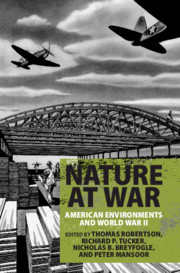Book contents
- Nature at War
- Nature at War
- Copyright page
- Contents
- Figures
- Tables and Charts
- Maps
- Contributors
- Preface
- Acknowledgments
- Introduction
- Part I New Weapons, New Spaces
- Part II Military Materials I (metals and energy)
- Part III Military Materials II (foods and plants)
- Part IV New Landscapes
- Part V New Frontiers
- 10 Battling Insects and Infection
- 11 Shattered Worlds
- Part VI Conservation
- Index
10 - Battling Insects and Infection
American Chemical and Pharmaceutical Expansion during World War II
from Part V - New Frontiers
Published online by Cambridge University Press: 25 March 2020
- Nature at War
- Nature at War
- Copyright page
- Contents
- Figures
- Tables and Charts
- Maps
- Contributors
- Preface
- Acknowledgments
- Introduction
- Part I New Weapons, New Spaces
- Part II Military Materials I (metals and energy)
- Part III Military Materials II (foods and plants)
- Part IV New Landscapes
- Part V New Frontiers
- 10 Battling Insects and Infection
- 11 Shattered Worlds
- Part VI Conservation
- Index
Summary
World War II marked a dramatic success for military medicine. Among the 16 million American soldiers who served during the war, approximately 405,000 died – a horrifying number, but one that could have been much higher.1 Injured soldiers’ chances of surviving surpassed that of any previous war – and were twice that of World War I.2 Numerous factors explain this success – from the availability of whole blood to streamlined transportation – but new chemical and biological treatments stand out as life savers. Previously, soldiers had died from wound infections; insect-borne diseases, such as typhus and malaria; and sexually transmitted diseases, such as syphilis and gonorrhea. Now new, effective treatments greatly reduced morbidity and mortality rates.3 However, this heralded success had environmental and public health implications for military and civilian life, both during the war and in the years that followed.
- Type
- Chapter
- Information
- Nature at WarAmerican Environments and World War II, pp. 275 - 297Publisher: Cambridge University PressPrint publication year: 2020



